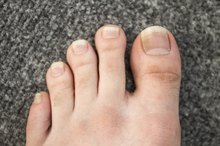What does fact checked mean?
At Healthfully, we strive to deliver objective content that is accurate and up-to-date. Our team periodically reviews articles in order to ensure content quality. The sources cited below consist of evidence from peer-reviewed journals, prominent medical organizations, academic associations, and government data.
- Ingrown toenail: Overview. (2018).
- Ingrown toenail: Overview. (2018).
- Mayo Clinic Staff. (2015). Osteomyelitis.
- Mayo Clinic Staff. (2018). Ingrown toenails.
- Ogur R, et al. (2005). Managing infected ingrown toenails.
- Ogur R, et al. (2005). Managing infected ingrown toenails.
The information contained on this site is for informational purposes only, and should not be used as a substitute for the advice of a professional health care provider. Please check with the appropriate physician regarding health questions and concerns. Although we strive to deliver accurate and up-to-date information, no guarantee to that effect is made.
Amoxicillin for Ingrown Toenail
An ingrown toenail develops when the nail grows into the flesh of the toe, causing pain, swelling and redness. In some cases, the ingrown toenail breaks through the skin and allows bacteria to enter the underlying tissues. The resulting infection is typically treated with an antibiotic such as amoxicillin.
Identification
When ingrown toenails allow the entry of organisms that cause an infection in the surrounding soft tissue, the condition is known as paronychia, notes MedlinePlus 3. People with paronychia have very painful and reddened toes, and may develop pus-filled blisters. Paronychia caused by bacterial infections develops suddenly, while fungal infections grow over time.
Effects
Amoxicillin for Cellulitis
Learn More
Amoxicillin is one of the penicillin-like antibiotics that kill specific types of beta-lactamase-producing bacteria. Paronychia caused by Streptococcus, Staphylococcus or E. coli typically responds well to oral amoxicillin, says RxList.
Dosage
According to Drugs.com, doctors usually prescribe either 250 to 500 mg of amoxicillin three times a day or 500 to 875 mg orally twice a day for adults with paronychia. Infections of the skin and skin structure in children from 4 weeks to 3 months of age are treated with 20 to 30 mg of amoxicillin per day for every kg of body weight. For children from 4 months through 12 years of age with infections from infected toenails, doctors prescribe 20 to 50 mg per day for every kg of body weight. Pediatric doses are divided into two or three equal doses a day.
- According to Drugs.com, doctors usually prescribe either 250 to 500 mg of amoxicillin three times a day or 500 to 875 mg orally twice a day for adults with paronychia.
- Infections of the skin and skin structure in children from 4 weeks to 3 months of age are treated with 20 to 30 mg of amoxicillin per day for every kg of body weight.
Forms
What Is the Difference Between Cellulitis & Mrsa?
Learn More
Amoxicillin is widely available in dosage forms that work for virtually everyone. These include oral suspensions for infants and toddlers, chewable tablets for older children and regular tablets or capsules for those who can safely swallow pills.
Contraindications
Penicillin and penicillin-like antibiotics can cause a severe life-threatening allergy known as anaphylaxis. Individuals with demonstrated allergies to penicillin, ampicillin, dicloxacillin, oxacillin, carbenicillin or combination products like amoxicillin and clavulanate should not take amoxicillin, says RxList. People who have a history of allergies to cephalosporin antibiotics like cephalexin, cefdinir and cefprozil are at greater risk for an amoxicillin allergy. Patients should share drug allergy histories with prescribing doctors before taking a new antibiotic.
- Penicillin and penicillin-like antibiotics can cause a severe life-threatening allergy known as anaphylaxis.
- People who have a history of allergies to cephalosporin antibiotics like cephalexin, cefdinir and cefprozil are at greater risk for an amoxicillin allergy.
Related Articles
References
- Majcen ME, et al. (2009). Interpretation of radiologic abnormalities in patients with chronically infected ingrown toenails with regard to a possible exogenic osteomyelitis. DOI:
- Mayo Clinic Staff. (2015). Osteomyelitis.
- Mayo Clinic Staff. (2018). Ingrown toenails.
- Ogur R, et al. (2005). Managing infected ingrown toenails.
- Peripheral arterial disease (PAD). (n.d.).
- Amoxil, Moxatag (amoxicillin) dosing, indications, interactions, adverse effects, and more.
- Soukavong M, Kim J, Park K, et al. Signal Detection of Adverse Drug Reaction of Amoxicillin Using the Korea Adverse Event Reporting System Database. J Korean Med Sci. 2016;31(9):1355-61. doi:10.3346/jkms.2016.31.9.1355
- Stein GE, Gurwith MJ. Amoxicillin-potassium clavulanate, a beta-lactamase-resistant antibiotic combination. Clin Pharm. 1984;3(6):591-9.
- Thomas VM, Thomas-eapen N. An Uncommon Side Effect of a Commonly Used Antibiotic: Amoxicillin-Clavulanic Acid Induced Hepatitis. Korean J Fam Med. 2017;38(5):307-310. doi:10.4082/kjfm.2017.38.5.307
- Millard G. Further experience with augmentin in the treatment of skin infections. Scott Med J. 1982;27 Spec No.:S35-8. doi:10.1177/00369330820270S108
- Blaser M. Antibiotic overuse: Stop the killing of beneficial bacteria. Nature. 2011;476(7361):393-4. doi:10.1038/476393a
- Zaman SB, Hussain MA, Nye R, Mehta V, Mamun KT, Hossain N. A Review on Antibiotic Resistance: Alarm Bells are Ringing. Cureus. 2017;9(6):e1403. doi:10.7759/cureus.1403
- Amoxil, Moxatag (amoxicillin) dosing, indications, interactions, adverse effects, and more.
- Augmentin, Augmentin XR (amoxicillin/clavulanate) dosing, indications, interactions, adverse effects, and more.
Writer Bio
Sandy Keefe, M.S.N., R.N., has been a freelance writer for over five years. Her articles have appeared in numerous health-related magazines, including "Advance for Nurses" and "Advance for Long-Term Care Management." She has written short stories in anthologies such as "A Cup of Comfort for Parents of Children with Special Needs."








